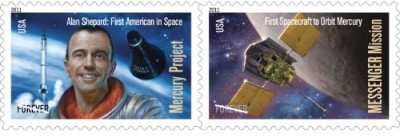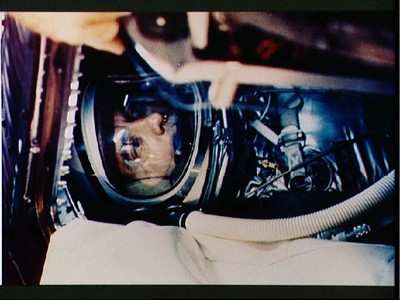Two Stamps Recognize 50th Anniversary Of First Manned
Spaceflight
The U.S. Postal Service dedicated two stamps Wednesday
commemorating two historic events — one that occurred a half
century ago, and the second that's making history now.

The 50th anniversary of America's first manned spaceflight and
an unmanned spacecraft currently charting planet Mercury were
commemorated today on two 44-cent First-Class Forever stamps. The
dedication ceremony took place next to a seven-story replica of the
rocket Alan Shepard piloted to become America's first man in space.
A second stamp celebrates the MESSENGER Mission spacecraft that is
currently orbiting and charting planet Mercury. "These two historic
missions — Shepard's Mercury flight that took place 50 years
ago tomorrow, and MESSENGER's current orbiting of Mercury —
frame a remarkable 50-year span in which America has advanced space
exploration through more than 1,500 manned and unmanned flights,"
said Stephen Masse, U.S. Postal Service vice president, finance and
planning, in dedicating the stamps. "The Postal Service is proud to
commemorate these achievements on stamps."
Joining Masse in the dedication was Laura Shepard Churchley,
Shepard's daughter; Scott Carpenter, Mercury astronaut; Charles
Bolden, NASA administrator and former Space Shuttle commander;
Robert Cabana, former Space Shuttle commander and current director,
Kennedy Space Center; and Jim Adams, NASA deputy director,
Planetary Science.

"These stamps, which will go out by the millions across this
country, are a testament to the thousands of NASA men and women who
shared dreams of human spaceflight and enlarging our knowledge of
the universe," said NASA Administrator Charles Bolden.
As the world watched on television, Shepard blasted off from
Cape Canaveral, FL, on May 5, 1961. The flight reached a maximum
speed of 5,100 mph, roughly eight times the speed of sound, and a
zenith of 116 miles above the Earth. With parachutes deploying, the
space capsule safely splashed down in the Atlantic some 300 miles
from the launch site. The New York Times declared that Shepard's
15-minute flight "roused the country to one of its highest peaks of
exultation since the end of World War II."
Emboldened by this achievement, President John F. Kennedy
declared in a historic speech on May 25, 1961, that America "should
commit itself to achieving the goal, before this decade is out, of
landing a man on the moon and returning him safely to the
Earth."
The Mercury project set the country on a path that would lead to
the stunning Apollo 11 moon landing eight years later on July 20,
1969, a crowning technological achievement of the 20th century.
On March 17, 2011, MESSENGER became the first spacecraft to
enter into orbit around Mercury. MESSENGER (MErcury Surface, Space
ENvironment, GEochemistry, and Ranging) is a scientific mission to
investigate Mercury, which some scientists say is "the
least-studied terrestrial planet" in our solar system. Launched
from Cape Canaveral Air Force Station, FL, on Aug. 3, 2004, the
spacecraft made six "flybys" of planets, including one of Earth,
two of Venus, and three of Mercury. The flybys were done to collect
data, to conserve fuel through gravity assists, and to make
adjustments critical to achieving the precise trajectory for
successfully inserting the spacecraft into orbit around
Mercury.

NASA image
Entering orbit in March 2011 represented a major milestone in
space exploration. The data obtained by MESSENGER before and during
the year-long orbit will be analyzed for many years to come.
Scientists think the data may explain how the planet took shape and
also offer clues about the origin of the solar system.
Donato Giancola of Brooklyn, NY, illustrated the stamps under
the direction of Phil Jordan of Falls Church, VA, who based the
artwork on NASA photographs and images. The phrase "Mercury
Project," depicted on the stamp image was approved by NASA
officials who indicate the term is used interchangeably with
"Project Mercury" as noted in the text on the back of the stamp
sheet. The MESSENGER Mission stamp depicts the MESSENGER spacecraft
orbiting Mercury.
The Project Mercury and MESSENGER Mission Stamps are being
issued as Forever stamps. Forever stamps are always equal in value
to the current First-Class Mail one-ounce rate.
 ANN's Daily Aero-Linx (04.13.24)
ANN's Daily Aero-Linx (04.13.24) ANN's Daily Aero-Term (04.13.24): Beyond Visual Line Of Sight (BVLOS)
ANN's Daily Aero-Term (04.13.24): Beyond Visual Line Of Sight (BVLOS) Airborne 04.09.24: SnF24!, Piper-DeltaHawk!, Fisher Update, Junkers
Airborne 04.09.24: SnF24!, Piper-DeltaHawk!, Fisher Update, Junkers Aero-News: Quote of the Day (04.14.24)
Aero-News: Quote of the Day (04.14.24) ANN's Daily Aero-Term (04.14.24): Maximum Authorized Altitude
ANN's Daily Aero-Term (04.14.24): Maximum Authorized Altitude





